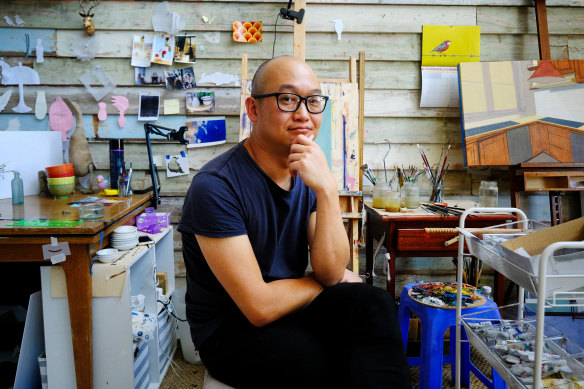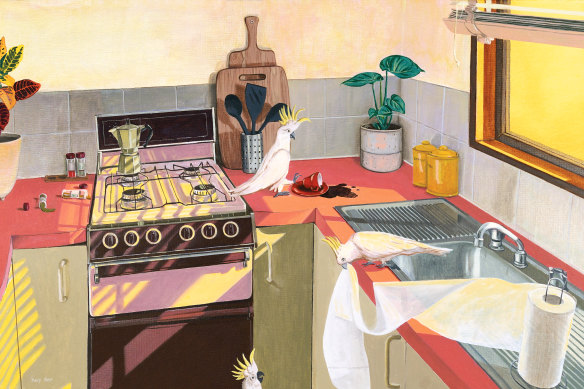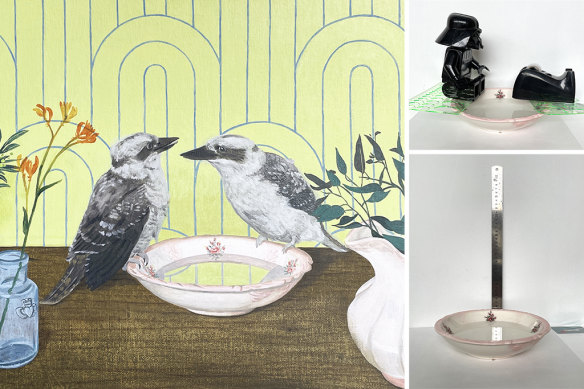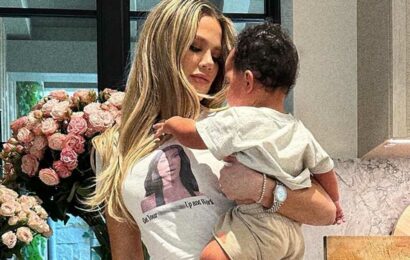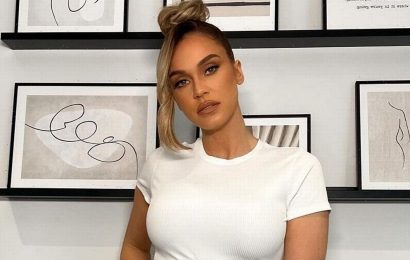Hop Dac had stopped painting for almost a decade – and then the pandemic happened. There hadn’t been a specific moment when the Geelong-based artist decided to give it up; it just slowly dropped away in between balancing study and work, until it was no longer the significant part of his life it once was.
Artist Hop Dac in his Geelong studio.Credit:Luis Enrique Ascui
In 1995 Dac left his home in Geraldton, a coastal town about five hours north of Perth, to attend art school at Curtin University. It was a revelation. “That was really, really great for me as someone who grew up in a country town with a refugee background and not having parents who took me to galleries or anything,” he tells me. “It was a really important way for me to soak up everything that came before”.
He describes the years following his graduation as being in a kind of wilderness. While the skill and passion were there, it was difficult to see how to build a career out of art. He’d done printmaking at university, but in order to pursue that outside of study you need to have your own press and a space, “neither of those things I could have or afford”.
In the years following, Dac continued painting and did further study, but it was difficult to know where to direct his energies. In 2002 he moved to Melbourne. In all that time he “had studios and enjoyed painting but never really did much beyond selling to friends or having exhibitions in weird places like pubs and stuff,” he reflects. His work shifted more towards writing and editing – he worked at literary journal Kill Your Darlings, with later roles at Carers Victoria and the Australian Institute of Family Studies.
There were a few occasions when art did manage to fit into some of the small gaps in his life. After his first daughter was born, Dac would read to her. Noticing that many of the books were illustrated with watercolour or gouache he was inspired to get his brushes out and try and improve his watercolour skills. There was similar inspiration following the birth of his second daughter in 2018. “I’d try and do a little watercolour every night after everyone had gone to bed,” he tells me. “But that was it – there wasn’t much other painting.”
Golden Hour by artist Hop Dac.Credit:Hop Dac
Dac found a studio space and started getting back into creating new works in early 2021. “I was seeing a psych for the first time, because of COVID,” he tells me. “It was bringing up a whole bunch of war trauma stuff and a lot of the things that I’d buried from my experiences growing up in a country town that wasn’t necessarily very receptive to Vietnamese people in the ’80s and ’90s.”
At first, Dac’s return to painting was a way to work through his emotions and help with his mental health. He describes art as a place where he can always find healing. “When I’m able to have time to figure out how to paint a picture, there’s something about that process of figuring out a picture that helps to straighten me out.”
As the year progressed and with his government job drawing to a close, however, he decided that instead of looking for a similar role elsewhere he would turn to art full time. In a time when working as an artist was particularly unpredictable and volatile, it was a bold move. “It was scary because I only had enough money for a couple of months,” Dac says matter-of-factly.
There’s a lot of problem-solving involved in creating his works. “A lot of my still lives are constructions rather than working from life,” he explains. In one recent commission, Dac has been working on a picture of kookaburras sitting on the edge of a bowl. “I don’t have kookaburras at my disposal, so I need to be innovative or imaginative about how I figure out how the reflections would work,” he says. So, for this painting he carefully balanced a Darth Vader toy and a sticky tape dispenser on rulers in place of the birds, and used a ruler to help work out how lines would be warped in the water.
A work in progress by artist Hop Dac, with kookaburras inspired by a photograph by Imelda Cribbin.Credit:Hop Dac
His paintings are often indoor scenes featuring plants and wildlife with the occasional surreal slant. Cockatoos wreak havoc in a kitchen, kicking over coffee cups and pulling at paper towel. A woman holds up her hand, while one bird perches on her finger and another peers out of her sleeve. A goose hides behind the leg of a plastic table which is laden with chopsticks and a plate of vegetables. Food and restaurant scenes are recurring images in Dac’s work.
“All those things that you used to do with your family and the food that you eat, they all remind you of where you come from,” he reflects. “I don’t have the luxury of being surrounded by the community of my heritage,” he tells me. “[Those things] become so much more important as a way to cling to community or identity than when you’re surrounded by them.”
More than a year on from making his decision, how is it all going? “Pretty good,” he replies quietly. In late 2022 he featured in a group show at Geelong’s Boom Gallery, and his work was shortlisted for both the National Emerging Art Prize and the Biblio Art Prize. In June this year, he will have his first solo show. Commissions have also steadily been coming in. “So lots of really great feedback that I was on the right path, and that was doing the right things,” he says.
“There’s lots of people who I think … because of the pandemic, they’ve had to take stock of what is important and what value you want to feel from your life,” he reflects. “For me, if it wasn’t for the pandemic, I probably wouldn’t have taken the leap of faith to make art my day job – and if it wasn’t for the Vietnam War, and my parents wouldn’t have met. It’s that weird thing where out of terrible situations, there is something positive that happens.
“I think if you are a creative person, or if you have dreams, or you want to do things then there’s no better time to do it than now because everyone is wondering what is important and what is the secret to happiness – the secret to happiness is doing all the things that you said you couldn’t or … weren’t able to do or don’t deserve to.”
The author of this article also worked at Kill Your Darlings.
A cultural guide to going out and loving your city. Sign up to our Culture Fix newsletter here.
Most Viewed in Culture
From our partners
Source: Read Full Article
